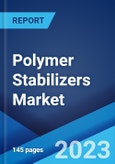The global polymer stabilizers market size reached US$ 6.9 Billion in 2022. Looking forward, the publisher expects the market to reach US$ 9.1 Billion by 2028, exhibiting a growth rate (CAGR) of 4.55% during 2023-2028.
Polymer stabilizers are chemical additives that are used in polymers and various plastics, such as polypropylene, polyethylene, and acrylonitrile butadiene styrene (ABS), to inhibit the radical reaction and oxidative degradation. They aid in eliminating defects from manufactured goods, reducing the risk of decolorization, and stabilizing the ultraviolet (UV) radiation. This, in turn, assists in ensuring faster production of plastic products, while retaining their physical properties. Polymer stabilizers offer longevity, flexibility, recyclability, and reliability, due to which they find extensive applications in various end-user industries. At present, they are commercially available in varying types, such as antioxidant, light, and heat stabilizers.
Polymer stabilizers are chemical additives that are used in polymers and various plastics, such as polypropylene, polyethylene, and acrylonitrile butadiene styrene (ABS), to inhibit the radical reaction and oxidative degradation. They aid in eliminating defects from manufactured goods, reducing the risk of decolorization, and stabilizing the ultraviolet (UV) radiation. This, in turn, assists in ensuring faster production of plastic products, while retaining their physical properties. Polymer stabilizers offer longevity, flexibility, recyclability, and reliability, due to which they find extensive applications in various end-user industries. At present, they are commercially available in varying types, such as antioxidant, light, and heat stabilizers.
Polymer Stabilizers Market Trends:
The widespread adoption of polymer stabilizers across various industrial verticals, such as automotive, commercial, construction, and packaging, for promoting the longevity of several plastic-based products and packs is one of the key factors driving the market toward growth. The increasing demand for ultraviolet (UV), eco-friendly, and heat-resistant coating components, such as polymer stabilizer, to protect the products and packaging materials of convenient and ready-to-eat (RTE) food items from deterioration is further supporting the market growth. In line with this, the increasing demand for hindered amine light stabilizers (HALS) for inhibiting chain scission, crosslinking, and surface cracking of polyethylene (PE) and polyethylene (PP) is acting as another growth-inducing factor. The rising requirement of energy-efficient plastics in the real estate and construction sector for eliminating environmental footprints due to the escalating environmental consciousness amongst consumers is further contributing to the market growth. Increasing construction activities are also expected to facilitate an increase in the use polymer stabilizers in the manufacturing of pipes, fittings, conduits, decking, and roofing, which, in turn, is propelling the market growth. Other factors, such as the usage of polymer stabilizers in the agriculture sector for creating tunnels and mulches, and protecting the crops from extreme high temperatures are creating a positive outlook for the market.Key Market Segmentation:
The publisher provides an analysis of the key trends in each sub-segment of the global polymer stabilizers market report, along with forecasts at the global, regional and country level from 2023-2028. The report has categorized the market based on product type and end use industry.Breakup by Product Type:
- Antioxidants
- Heat Stabilizer
- Light Stabilizer
- Others
Breakup by End Use Industry:
- Packaging
- Automotive
- Consumer Goods
- Building and Construction
- Others
Breakup by Region:
- North America
- United States
- Canada
- Asia-Pacific
- China
- Japan
- India
- South Korea
- Australia
- Indonesia
- Others
- Europe
- Germany
- France
- United Kingdom
- Italy
- Spain
- Russia
- Others
- Latin America
- Brazil
- Mexico
- Others
- Middle East and Africa
Competitive Landscape:
The competitive landscape of the industry has also been examined along with the profiles of the key players being Adeka Corporation, Albemarle Corporation, Baerlocher GmbH, BASF SE, Chitec Technology Co. Ltd., Clariant AG, Evonik Industries AG, R.T. Vanderbilt Holding Company Inc., SABO S.p.A., Solvay S.A., SONGWON Industrial Co. Ltd. and Valtris Specialty Chemicals.Key Questions Answered in This Report:
- How has the global polymer stabilizers market performed so far and how will it perform in the coming years?
- What has been the impact of COVID-19 on the global polymer stabilizers market?
- What are the key regional markets?
- What is the breakup of the market based on the product type?
- What is the breakup of the market based on the end use industry?
- What are the various stages in the value chain of the industry?
- What are the key driving factors and challenges in the industry?
- What is the structure of the global polymer stabilizers market and who are the key players?
- What is the degree of competition in the industry?
Table of Contents
1 Preface3 Executive Summary10 Value Chain Analysis12 Price Analysis
2 Scope and Methodology
4 Introduction
5 Global Polymer Stabilizers Market
6 Market Breakup by Product Type
7 Market Breakup by End Use Industry
8 Market Breakup by Region
9 SWOT Analysis
11 Porters Five Forces Analysis
13 Competitive Landscape
Companies Mentioned
- Adeka Corporation
- Albemarle Corporation
- Baerlocher GmbH
- BASF SE
- Chitec Technology Co. Ltd.
- Clariant AG
- Evonik Industries AG
- R.T. Vanderbilt Holding Company Inc.
- SABO S.p.A.
- Solvay S.A.
- SONGWON Industrial Co. Ltd.
- Valtris Specialty Chemicals.
Methodology

LOADING...
Table Information
| Report Attribute | Details |
|---|---|
| No. of Pages | 145 |
| Published | September 2023 |
| Forecast Period | 2022 - 2028 |
| Estimated Market Value ( USD | $ 6.9 Billion |
| Forecasted Market Value ( USD | $ 9.1 Billion |
| Compound Annual Growth Rate | 4.7% |
| Regions Covered | Global |
| No. of Companies Mentioned | 12 |









